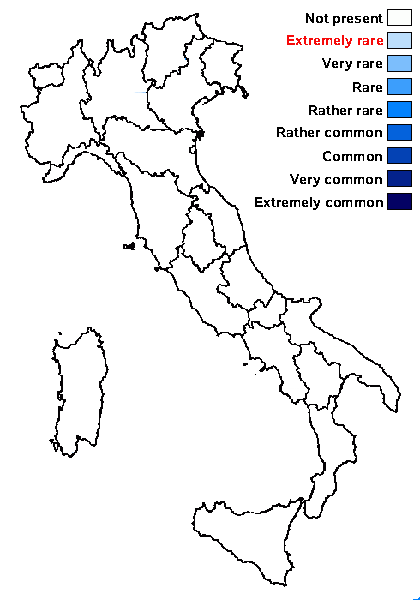Heteroplacidium acervatum (Breuss) Breuss
Ann. naturhist. Mus. Wien, Ser. B, Bot. Zool. 98 (Suppl.): 40, 1996. Basionym: Catapyrenium acervatum Breuss - Linzer biol. Beitr., 28, 1: 525, 1996
Synonyms:
Distribution:
Description: Thallus squamulose, of scattered to contiguous squamules usually forming compact, cushion-like aggregates, the squamules 0.3-3 mm wide, 0.25-0.4 mm thick, irregularly rounded to slightly lobed, convex, pale to medium brown, matt, greyish towards the margins; lower surface brown, attached by colourless, 3-5 μm thick rhizohyphae which aggregate in the central parts of squamules into a stipe-like organ. Upper cortex 25-45 μm thick, paraplectenchymatous, with or without a thin epinecral layer; medulla white in upper part, brownish in lower part, of spherical hyphae; lower cortex not clearly delimited from the medulla. Perithecia black, subglobose, up to 0.35 mm wide, immersed in the squamules, without involucrellum. Exciple up to 30 μm thick, pale except near the ostiole; paraphyses absent, substituted by periphyses. Asci 8-spored, clavate, I-, fissitunicate, the wall thickened above, Verrucaria-type. Ascospores 1-celled, hyaline, ellipsoid, 11-13 x 5-6 μm, biseriately arranged in the asci. Pycnidia laminal, black, immersed, of the Dermatocarpon-type. Conidia bacilliform, 4-7 x 1-1.5 μm. Photobiont chlorococcoid (Myrmecia. Spot tests: cortex and medulla K-, C-, KC-, P-, UV-. Chemistry: without lichen substances.Note: a Mediterranean species growing directly on calcareous rocks, known from the Iberian Peninsula and the Balearic Islands; to be looked for in Mediterranean Italy.
Growth form: Squamulose
Substrata: rocks
Photobiont: green algae other than Trentepohlia
Reproductive strategy: mainly sexual

Predictive model
Growth form: Squamulose
Substrata: rocks
Photobiont: green algae other than Trentepohlia
Reproductive strategy: mainly sexual

Predictive model
 Index Fungorum
Index Fungorum
 GBIF
GBIF

